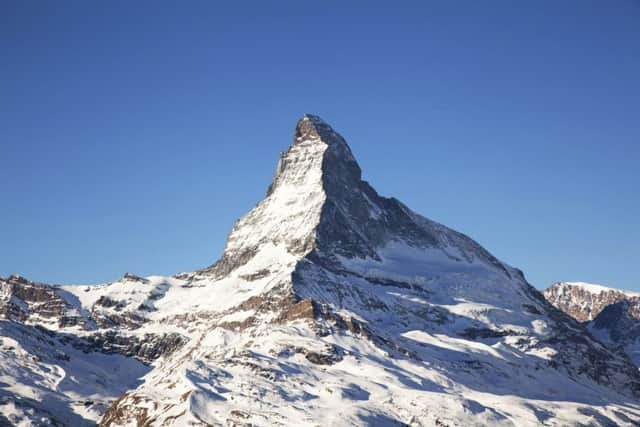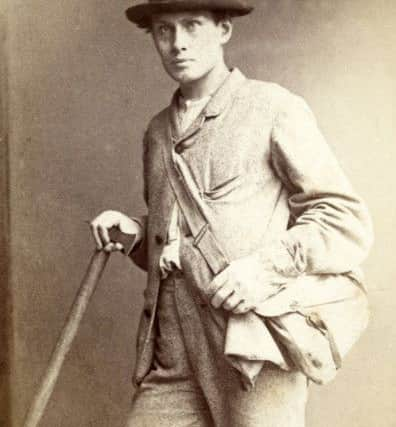The first ascent of the Matterhorn ended in tragedy but gave climbing a boost


The tragedy on 14 July, 1865, claimed the lives of four men, including Lord Francis Douglas, 18, the son of the eighth Marquess of Queensberry, and Douglas Hadow, whose paternal great-grandfather George was a professor of Hebrew and oriental languages at the University of St Andrews.
Their deaths shocked the British public – so much so that Queen Victoria considered banning mountaineering altogether.
Advertisement
Hide AdAdvertisement
Hide AdThe idea was dismissed as unworkable but the uproar raged on, with some even claiming that the rope which broke had been deliberately cut by one of the three survivors in order to save their lives.


Robin Campbell, librarian and former president of the Scottish Mountaineering Club, says: “The Matterhorn accident was a pretty disastrous affair, with the newspapers of the time all calling for a stop to mountaineering.
“It brought the whole business of mountaineering to the attention of the public. Since then, every time there is a shocking accident it attracts the same kind of attention.”
It was a book by another Scot, James David Forbes, principal of the University of St Andrews, which had been instrumental in drawing attention to the Alpine peaks such as the Matterhorn.
“Travels Through The Alps of Savoy, which was published in 1843, was enormously influential,” says Robin, who is a member of the Alpine Club. His Alpine experience includes climbing Monte Rosa, the second-highest peak in the Alps.
More than 20 years after that book came out, the Matterhorn, at 4,478m, was still unconquered and it became something of an obsession for Englishman Edward Whymper, who made several unsuccessful attempts at a first ascent between 1860 and 1865.
During the fateful summer of the accident, Whymper heard an attempt was to be made on the mountain by an Italian party and, determined to get there first, he formed a team, including Douglas, who had not long finished his education at Edinburgh Academy. A novice climber, he had managed to make a first ascent of the nearby Unter Gabelhorn (3,391m) with guide Peter Taugwalder in the summer of 1865.
Advertisement
Hide AdAdvertisement
Hide AdThe pair joined forces with Taugwalder, his two sons, Peter and Joseph, guide Michel Croz and two other British climbers, Charles Hudson and Hadow.
The race to the top began on 13 July, 1865, at dawn when the eight men climbed to a plateau at 2,552m to make camp. The next day, Joseph returned to Zermatt and the party of seven again set off at dawn to try to reach the summit, approaching first by the east face which was relatively straightforward.
By 11am they had reached the foot of the much steeper upper peak that lies above the shoulder of the mountain. Whymper later wrote that the less experienced Hadow “required continual assistance” at this point of the ascent, but, overcoming the difficulties, the group finally arrived near the summit. When they saw that only 200 feet of easy snow remained, Croz and Whymper detached themselves from the rope and reached the top first.
Whymper wrote: “The slope eased off, and Croz and I, dashing away, ran a neck-and-neck race, which ended in a dead heat. At 1:40pm the world was at our feet, and the Matterhorn was conquered. Hurrah! Not a footstep could be seen.”
However, the celebrations were shortlived, as tragedy was to strike on the way down when novice climber Hadow fell, knocking down Croz and also dragging Douglas and Hudson, who were connected by rope.
“I heard one startled exclamation from Croz, then saw him and Mr Hadow flying downwards; in another moment Hudson was dragged from his steps and Lord F Douglas immediately after him,” wrote Whymper later.
“All this was the work of a moment; but immediately we heard Croz’s exclamation, Taugwalder and myself planted ourselves as firmly as the rocks would permit; the rope was tight between us, and the shock came on us as on one man. We held; but the rope broke midway between Taugwalder and Lord F Douglas.
Advertisement
Hide AdAdvertisement
Hide Ad“For two or three seconds we saw our unfortunate companions sliding downwards on their backs, and spreading out their hands endeavouring to save themselves; they then disappeared one by one and fell from precipice to precipice on to the Matterhorn glacier below, a distance of nearly 4,000 feet in height. From the moment the rope broke it was impossible to help them.”
It wasn’t until the next day that the bodies of Croz, Hudson and Hadow were recovered. However, while a boot, a belt and a pair of gloves belonging to Douglas were discovered, his body was never found.
Whymper later claimed that an old rope, which was supposed to have been used only as a reserve, had inadvertently been used to connect the three survivors to the others who had been tied together with stronger ropes.
However, the accident sparked a huge controversy, with some claiming Taugwalder had cut the rope to save himself, his son and Whymper.
Others said it was actually Hadow who reached the top of the Matterhorn first and his death was deliberately caused by Whymper, who wanted to take the glory.
The accusations continued despite an inquiry in Zermatt which cleared the guide of all blame.
Author and Scottish mountaineer Andy Nisbet – who was part of a team of four who made one of the early British ascents of the Matterhorn’s notoriously difficult north face in the winter of 1977 – points out that the equipment of the time was very basic.
Advertisement
Hide AdAdvertisement
Hide Ad“They only had ropes and these weren’t very good and would easily have broken if the leader took a fall,” says Nisbet, another past president of the Scottish Mountaineering Club.
“Nowadays there is fixed equipment on a lot of the difficult bits and an emergency hut half-way up, but they would have had nothing like that. They were extraordinarily brave.
“I imagine the majority of people at the time would have been horrified and thought it was crazy and I think most people now still believe mountaineering is for crazy people.
“However, you will always get a percentage that thinks, ‘That sounds exciting, I’d like to give it a go’.”
Whymper, while maintaining he was devastated by the tragedy, didn’t stop exploring and his memoir Scrambles Amongst the Alps has become one of the classics of climbing history.
The Matterhorn accident was reported all over the world and despite the criticism levelled at the sport, its popularity grew, with interest increasing as a result of all the publicity.
Membership of the British Alpine Club, which was founded in 1857 by climbing enthusiasts, including Forbes, to promote climbing as an activity free of rules and regulations, also increased. Club members were encouraged to describe and depict their endeavours, and notable members included the young John Ruskin (1819-1900).
Advertisement
Hide AdAdvertisement
Hide AdA unique opportunity to view the 19th century artwork commissioned by the Alpine Club is currently available to visitors to the heart of the Alps in Chamonix, the home of Croz and the place where Whymper died in 1911.
An exhibition, which includes guides’ diaries and paintings by artists such as Edward T Compton and Sir Robert P Collier, is being held from now until April in the newly refurbished Musee Alpin near the centre of town.